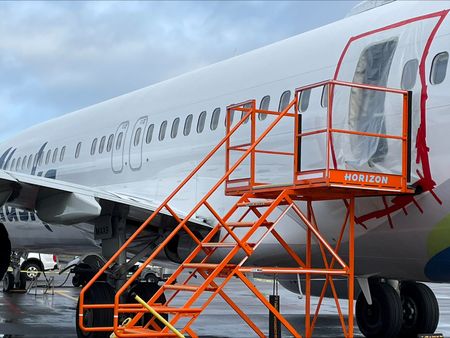By Valerie Insinna and Tim Hepher
(Reuters) – Boeing does not typically make adjustments to the type of panel involved in last week’s 737 MAX 9 blowout unless factory tests reveal a problem, a source familiar with Boeing’s industrial process said on Friday.
Sources told Reuters last week Boeing supplier Spirit AeroSystems sends semi-completed fuselages from its factory to Boeing with the special panel, which replaces an optional emergency exit, fitted but not completed.
Those sources said Boeing workers usually remove the panel, and use the gap to install pieces of cabin equipment, before replacing the panel and finishing the installation. But the source familiar with Boeing’s industrial process said on Friday that according to its standard factory procedures, the company only removes or adjusts the panel if there are signs it was installed incorrectly. Boeing does perform certain checks and conducts pressurization tests before delivering the plane to the airline, the source said, adding that interiors are loaded elsewhere in the plane.
All the sources were speaking about standard production procedures, and not specifically about the Alaska Airlines jet that was forced to make an emergency landing a week ago because a panel had torn off mid-air and left a gaping hole in the fuselage.
A clearer understanding of the industrial processes involving Boeing’s largest single-aisle plane will help investigators determine whether design or manufacturing played a role in the accident.
Boeing and Spirit AeroSystems declined to comment. Reuters could not independently verify the production practices, which are being investigated by the Federal Aviation Administration. The National Transportation Safety Board is conducting a separate investigation into the causes of the accident.
The sources did not wish to be identified because of the ongoing investigations.
On Thursday, the FAA, which assumed responsibility for signing off individual MAX planes following an earlier safety crisis, announced a formal investigation into the MAX 9. FAA chief Mike Whitaker told Reuters he saw the MAX 9 problems as a manufacturing issue, not a design problem.
The aerospace industry is in a state of flux due to supply and labor shortages, which force many manufacturers to use workarounds to maintain production, making it difficult for observers to monitor exact production flows. The Air Current reported this week that the plug for the optional emergency exit is not typically removed by Boeing unless there is a “rigging” or installation issue, while adding that Boeing does do quality checks. The door plug tore off the side of the Alaska Airlines jet at 16,000 feet as it climbed out of Portland, Oregon, on Jan. 5, prompting the FAA to ground over 170 similar planes. The source familiar with Boeing’s industrial process said the plug is secured vertically inside the aircraft fuselage by four bolts – two that connect the upper guide roller to a fastener near the top of the plug and two at the bottom hinges – which keep the plug from being able to shift up and down.
Reuters could not determine at what stage of the production process those bolts are secured, nor what checks Boeing is responsible for. Industry sources briefed on the matter said there were conflicting accounts over who does what, with at least one source questioning how complete the panel installation is when the fuselages leave Spirit.
After the plane enters service, airlines typically remove the plug every two years or so for maintenance, the source said, adding that cabins are loaded through larger doors. Quality controls are under scrutiny after airlines reported loose bolts in other aircraft in the wake of the accident.
(Reporting by Tim Hepher in Paris and Valerie Insinna in Washington; Editing by Muralikumar Anantharaman)

